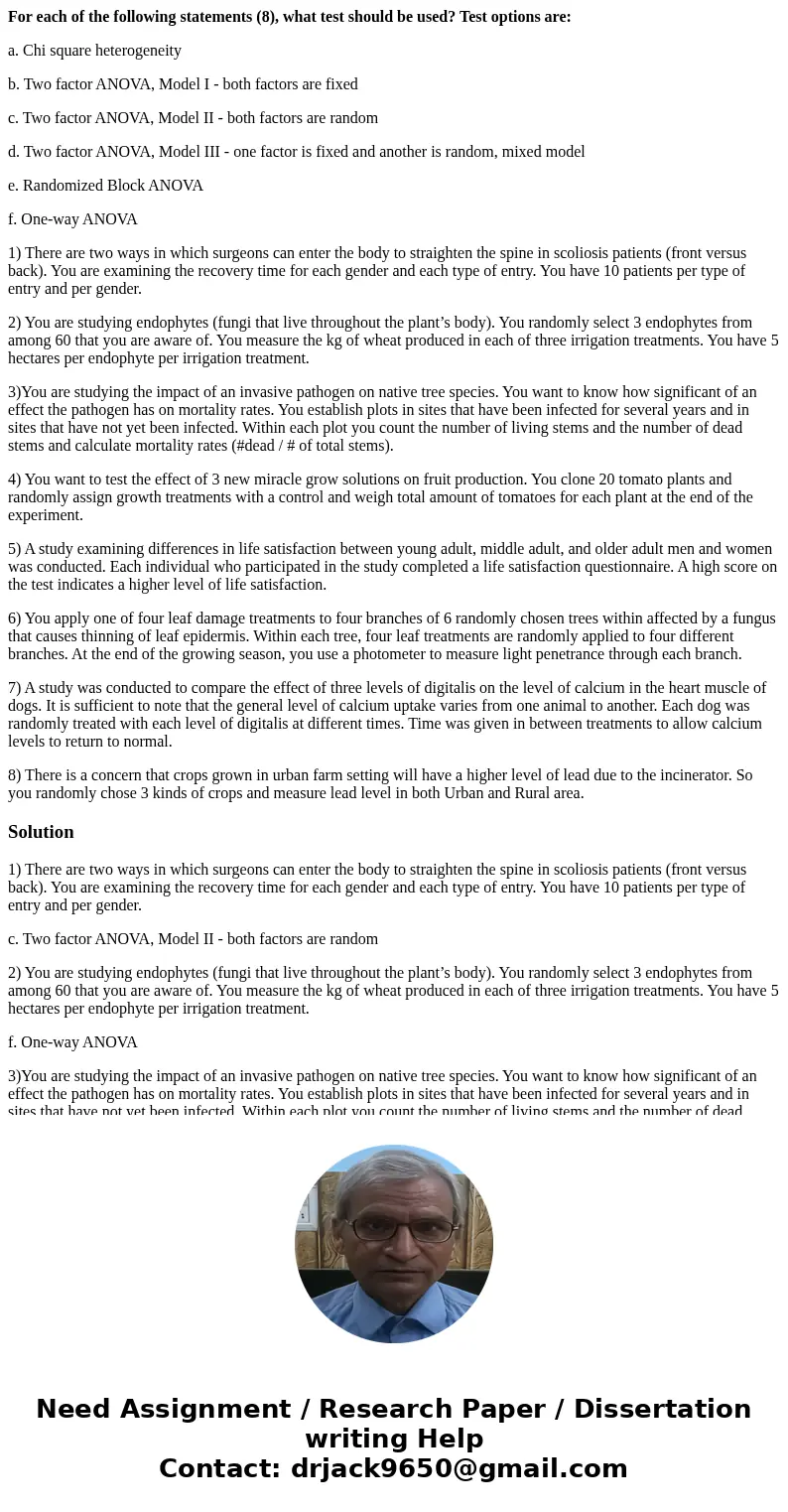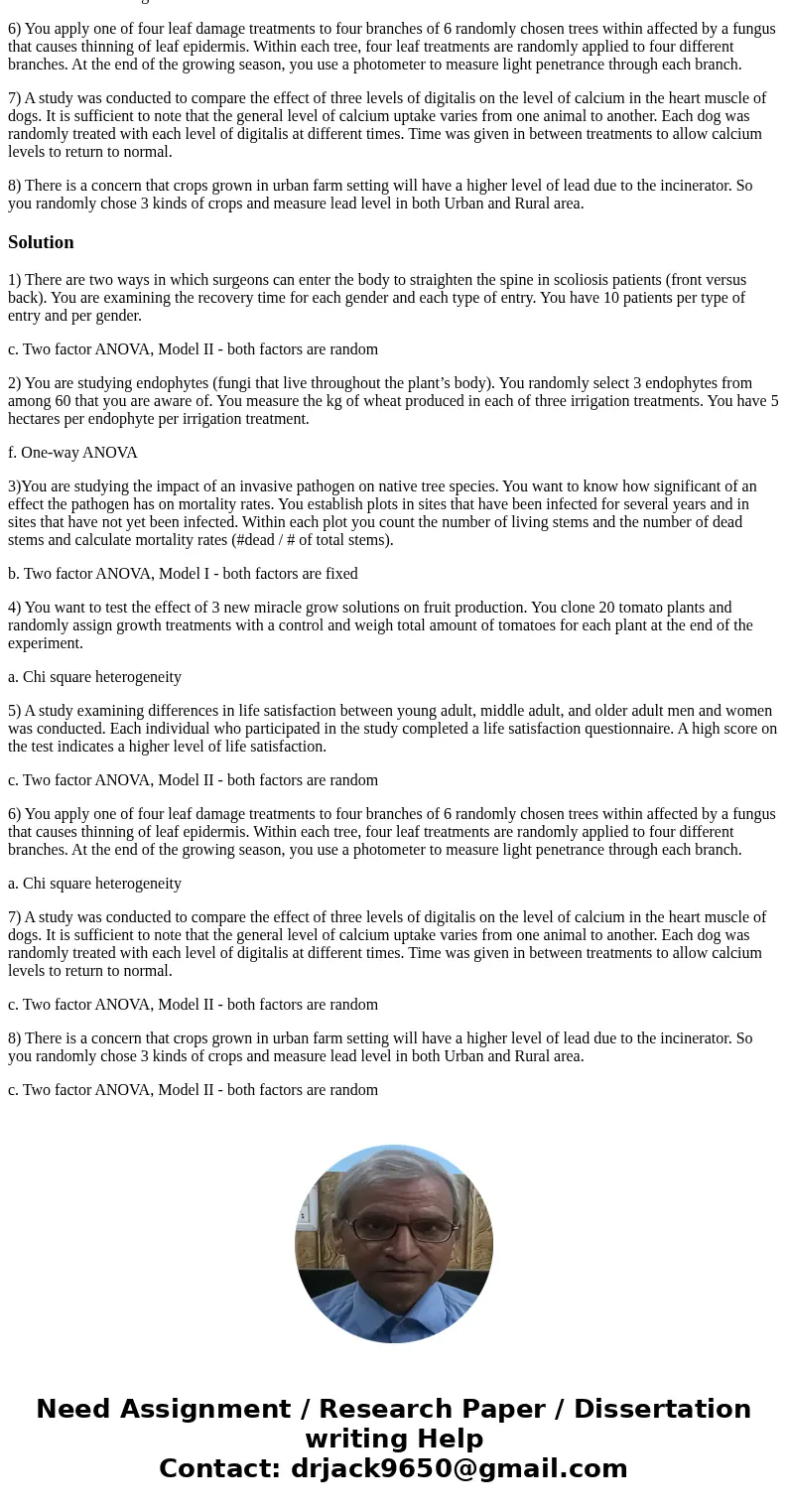For each of the following statements 8 what test should be u
For each of the following statements (8), what test should be used? Test options are:
a. Chi square heterogeneity
b. Two factor ANOVA, Model I - both factors are fixed
c. Two factor ANOVA, Model II - both factors are random
d. Two factor ANOVA, Model III - one factor is fixed and another is random, mixed model
e. Randomized Block ANOVA
f. One-way ANOVA
1) There are two ways in which surgeons can enter the body to straighten the spine in scoliosis patients (front versus back). You are examining the recovery time for each gender and each type of entry. You have 10 patients per type of entry and per gender.
2) You are studying endophytes (fungi that live throughout the plant’s body). You randomly select 3 endophytes from among 60 that you are aware of. You measure the kg of wheat produced in each of three irrigation treatments. You have 5 hectares per endophyte per irrigation treatment.
3)You are studying the impact of an invasive pathogen on native tree species. You want to know how significant of an effect the pathogen has on mortality rates. You establish plots in sites that have been infected for several years and in sites that have not yet been infected. Within each plot you count the number of living stems and the number of dead stems and calculate mortality rates (#dead / # of total stems).
4) You want to test the effect of 3 new miracle grow solutions on fruit production. You clone 20 tomato plants and randomly assign growth treatments with a control and weigh total amount of tomatoes for each plant at the end of the experiment.
5) A study examining differences in life satisfaction between young adult, middle adult, and older adult men and women was conducted. Each individual who participated in the study completed a life satisfaction questionnaire. A high score on the test indicates a higher level of life satisfaction.
6) You apply one of four leaf damage treatments to four branches of 6 randomly chosen trees within affected by a fungus that causes thinning of leaf epidermis. Within each tree, four leaf treatments are randomly applied to four different branches. At the end of the growing season, you use a photometer to measure light penetrance through each branch.
7) A study was conducted to compare the effect of three levels of digitalis on the level of calcium in the heart muscle of dogs. It is sufficient to note that the general level of calcium uptake varies from one animal to another. Each dog was randomly treated with each level of digitalis at different times. Time was given in between treatments to allow calcium levels to return to normal.
8) There is a concern that crops grown in urban farm setting will have a higher level of lead due to the incinerator. So you randomly chose 3 kinds of crops and measure lead level in both Urban and Rural area.
Solution
1) There are two ways in which surgeons can enter the body to straighten the spine in scoliosis patients (front versus back). You are examining the recovery time for each gender and each type of entry. You have 10 patients per type of entry and per gender.
c. Two factor ANOVA, Model II - both factors are random
2) You are studying endophytes (fungi that live throughout the plant’s body). You randomly select 3 endophytes from among 60 that you are aware of. You measure the kg of wheat produced in each of three irrigation treatments. You have 5 hectares per endophyte per irrigation treatment.
f. One-way ANOVA
3)You are studying the impact of an invasive pathogen on native tree species. You want to know how significant of an effect the pathogen has on mortality rates. You establish plots in sites that have been infected for several years and in sites that have not yet been infected. Within each plot you count the number of living stems and the number of dead stems and calculate mortality rates (#dead / # of total stems).
b. Two factor ANOVA, Model I - both factors are fixed
4) You want to test the effect of 3 new miracle grow solutions on fruit production. You clone 20 tomato plants and randomly assign growth treatments with a control and weigh total amount of tomatoes for each plant at the end of the experiment.
a. Chi square heterogeneity
5) A study examining differences in life satisfaction between young adult, middle adult, and older adult men and women was conducted. Each individual who participated in the study completed a life satisfaction questionnaire. A high score on the test indicates a higher level of life satisfaction.
c. Two factor ANOVA, Model II - both factors are random
6) You apply one of four leaf damage treatments to four branches of 6 randomly chosen trees within affected by a fungus that causes thinning of leaf epidermis. Within each tree, four leaf treatments are randomly applied to four different branches. At the end of the growing season, you use a photometer to measure light penetrance through each branch.
a. Chi square heterogeneity
7) A study was conducted to compare the effect of three levels of digitalis on the level of calcium in the heart muscle of dogs. It is sufficient to note that the general level of calcium uptake varies from one animal to another. Each dog was randomly treated with each level of digitalis at different times. Time was given in between treatments to allow calcium levels to return to normal.
c. Two factor ANOVA, Model II - both factors are random
8) There is a concern that crops grown in urban farm setting will have a higher level of lead due to the incinerator. So you randomly chose 3 kinds of crops and measure lead level in both Urban and Rural area.
c. Two factor ANOVA, Model II - both factors are random


 Homework Sourse
Homework Sourse